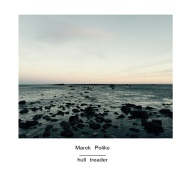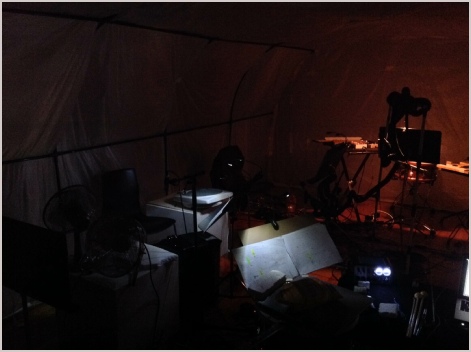Another Timbre TimHarrisonbre

at95 Marek Poliks - ‘hull treader’
1. ‘hull not continent’ (2014) 22:14 youtube extract
Distractfold: Rocío Bolaños (bass clarinet & percussion)
Daniel Brew (electric guitar) Linda Jankowska (violin)
Zinajda Kodrič (flutes) Emma Richards (percussion & sine tones)
2. ‘treader always in station’ (2014) 34:21 youtube extract
John Pickford-Richards & Beth Weisser (violas, objects, electronics)
Interview with Marek Poliks
'hull not continent' and 'treader always in station' are both distinctive and unusual titles. What do they refer to, and does this have any direct input into the music?
I want my music to invite people into material experiences of alien environments. It’s a trick, it’s a heuristic for embodiment. When I allow a sensation to belong to a self-sustaining world outside of my own - my world, the world I am responsible for maintaining - I can relax the more stubborn corners of my attention into my body. The more realistic the alien world, the greater the effect.
And, so, here come the titles:
‘hull not continent’ - this other world is not a place to live, but it’s a thing that keeps me safe.
‘[dawn] treader always in station’ - I’m leaving my body with my body, I’m leaving without leaving. (And for me the C.S. Lewis reference touches both sci-fi escapism and the obstacles of Cartesian dualism).
Your music is hard to categorise, which is one of its strengths for me. But I wonder how - if pushed - you would describe it? Not in terms of genre, but literally how you describe the kinds of sounds you are using, and how you organise them?
So again the goal is helping people feel safe and warm and in their bodies (if they need help doing so). I want them to explore or discover something concurrently with or as a means to embodiment. Each work has a central metaphor like alien environment and warmth, spaceship and cradling - also the club, and club music, which is always its own soundtrack.
I think these invitations have a gestural model, there is a push against a black hole of physical emergency. The push aspirates my music, and then it scurries into alien plants or radiators or sunlight or whatever. Sometimes it gets stuck and needs to articulate itself many times. Sometimes it works and I get to do my best electroacoustic impression of speculative field recordings for a long time. Everything collapses in service to the speculative world’s physics.
The push forms the skeleton of ‘hull’ - it might help to listen to the piece through that gestural model. ‘treader’ features the push too, but it’s a downward push, it’s a relaxing push actually - caverns after sub-basement after basement after basement - pushes after the first push.
You refer to an ‘electroacoustic impression of speculative field recordings’. Though both pieces are composed fully down to the finest detail, the soundworlds of both pieces remind me of electroacoustic improvisation. Is that a reference point for you and a genre that you are familiar with?
A lot of people have said this to me! I have a lot of respect for that field and I can sense the similarity. Most EAI has a materialist underpinning, right? - it honors the specific physicalities and agencies of the instruments and objects involved. One could go so far as to say that it takes these forces as its material. But I think that a materialist musical project inevitably amplifies the human interpretive physicality as well - a human hand exploring a metal disc reveals the disc but also discloses its fingers. Fingers seem central to EAI, at least as far as I understand it. I think my sci-fi materialism is almost in conflict with fingers? For now, I like the conflict.
I was struck by your decision to insert a long pause between the two pieces on the disc. Why did you want this silence?
It’s like an airlock. Each world has a different vibe-atmosphere, so we need to de/repressurize. I think it helps ‘treader’ establish its vibe on its own, less in relation to ‘hull’.
Could you say how you came to experimental music? Where did you start and what are the key things that brought you to where you are now?
Marilyn Manson! When I first heard ‘Mechanical Animals’, I was so struck by its sense of world. His music felt really empowering to me. Even though these worlds were horrible and creepy, they felt like places I could escape to. I would put on ‘Holy Wood’ and go to the ocean, and the music made the ocean more intense, more alien. Classic teen. From there to trance music, ambient, etc… eventually leading me to the avant-garde, which is kind of the ultimate escapism. The a-g works in totally platonic space - listening to it requires building these constellations of formal markers, internal and historical references, etc…. I liked that for a long time. At some point I realized that the a-g (and maybe even artmaking more generally) is actually the practice of distance - that between matter and its halo, ceremonial role, kyriarchal history, hologram. A-g art’s a type of gaze, whereby matter is owned and enframed and assumed into discourse. It’s romantic too. This gaze is the archetypal romantic gesture (the lifting, the elevation). Residual matter is cloaked in incense smoke. I’m generalizing, but I think you know what I mean?
And on the other hand, the escapism I’m after really isn’t romantic at all. I love to look at sci-fi handbooks and dictionaries and maps of fake planets. This kind of documentation gives me a necessary level of detail for the speculative world to feel realistic. I don’t think you can effect world through symbolic play - the goal is precisely to not be abstract! These days I listen to a lot of videogame soundtracks, to a lot of minimal house from the mid-aughts, and to lots and lots of trap music (which for me is really the music most engaged with a non-metaphorical viscerality). And of course the ambient and the goth/industrial/dark ambient have stuck with me. I think that the ‘Holy Wood’ project is where I’m ending up again - I want to amplify the ocean and make it more intense, not amplify my subjectivity in relation to the ocean.



Reviews
‘
Another Timbre is a truly great label, and I’m not sure it ever gets the recognition it justly deserves. It’s associated with the more ‘cerebral’ end of improv, and is especially entwined with the Wanderweiser group of composers. This CD has two long pieces, Hull Not Continent at 22:14 minutes long, and Treader Always In Station at 34:21 minutes; it comes wrapped in a sombre, sparsely decorated card wallet.
Writing about these works could well benefit from a learned hand on the keyboard - unfortunately, you’re stuck with me… But, in a nutshell, these recordings are cryptic, beautiful, and outright terrifying: they’re quite something. Hull Not Continent is performed by Distractfold, a quintet (bass clarinet & percussion, electric guitar, violin, flutes, percussion & sine tones), whilst Treader Always In Station is performed by a duo using violas, object & electronics. The cryptic element of the CD is, very simply, how are they achieving these sounds? The soundscape is one of scrapes, noises, and drones - all very achievable with extended techniques - but the level of control, and the deployment of sounds, is quite staggering. Certainly, proficient and imaginative recording would have helped - and indeed, Hull… is recorded by Another Timbre label boss Simon Reynell, a renowned sound recordist. However, even with lots of close-miking and room-recordings, it’s still unclear how the ensembles achieve the spatial depth and layers that they do. There is a definite sense of the sound-field contracting and expanding, foregrounding one instrument, whilst another echoes in the corner of the room. On top of this, there are points in Treader… which sound like more than the work of a mere two people. These cryptic elements became ‘outright terrifying’ with the knowledge that, as far as I can tell, the two works are not only performed live with no processing, but are actually composed by Poliks. This really does stretch the mind’s conception of what is achievable. If I was to tailor a simple description of both pieces for Musique Machine’s probable audience, I would limn them as academic, electroacoustic takes on the kind of acoustic scrape associated with the Chocolate Monk label and it’s peers. However, given that the CD contains (to the best of my knowledge) live performances of composed pieces - well, you can see that Marek Poliks has marshalled something really special here.
I appreciate that I’ve perhaps said very little about the actual content of Hull Treader, in my words above. So, as I said, we’re looking at scrapes, noises, and drones. Instruments stretched and strained, objects caressed and strangled. The kind of clatter utilised equally by numerous outfits in their basements with four-tracks, as by Lachenmann. It’s not always noisy, but ‘acoustic noise’ would push you in the right direction - though several passages of the CD are indeed very subdued and spacious. This in itself surprised me, as I have always - perhaps lazily - associated Another Timbre with often quiet, introspective pieces; here, though, Poliks sets up quite a sustained barrage of sound. This ‘barrage’, sometimes moving in little blocks, really is constantly engaging, but above all else it’s simply sumptuously beautiful sound. (That’s the last third of your ‘cryptic’ and ‘terrifying’ triptych.) Mesmerisingly detailed sounds and juxtapositions. I imagine quite a few people reading this might well be put off by the ‘academic’, serious tone that Another Timbre transmits, but ignore those trappings and just dive into the sound - you won’t be disappointed.’
Roger Batty, Musique Machine
“Marek Poliks’ new CD hull treader sounds, at first, like another type of electroacoustic improvisation. There are two pieces, separated by a minute’s silence. In each, the sounds are amplified or entirely electronic. Music appears as large blocks of timbre; typically moving from one block to the next in sequence. The sounds are complex, verging on noise; extended techniques prevail. In an interview, Poliks talks about his interest in industrial goth, dark ambient.
Strangely, closer investigation reveals the situation to be more complicated. Firstly, it’s significant that Poliks himself doesn’t play on this disc: the performers are the ensemble Distractfold the duet of John Pickford Richards and Beth Weisser on violas(!?) and electronics. I haven’t seen the score for these pieces, but others I have seen suggest that these works are fully notated, at least down to details of techniques motifs and finer points of phrasing.
Despite the often harsh and unfamiliar sounds we’ve returned, in a roundabout way, to a type of composition from the classical era, where notation sought to preserve and then mimic the spontaneous flow of improvised music. The techniques, means and materials are however very different, after the intervention of a century or so of new thinking. Poliks’ music takes some unexpected twists and turns, as though following some internal logic beyond the knowledge of the performers. There are sudden, decisive shifts in tone, like the ominous rumble that suddenly appears a third of the way through the viola duet treader always in station and then refuses to leave. It’s like taking in a landscape – industrial, or post-industrial, in this case – only to discover the scene is in fact a vast organism with a mind of its own.”
Ben Harper, Boring like a drill
Discount price £5